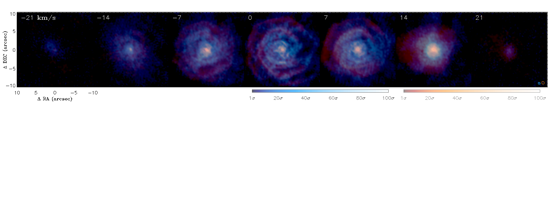|
圖片來源: Hyosun Kim, Sheng-Yuan Liu, Naomi Hirano, et al.

Spiral-shell circumstellar pattern of CIT 6 is revealed in our SMA CO J=2-1 channel maps, in blue, shown atop the earlier VLA HC3N J=4-3 (Claussen et al. 2011) in red. In addition, non-spherical outflow in the central region is clearly seen at the edge velocity channels (i.e., about -20 km/s and 20 km/s). The channel center velocity with respect to the systemic velocity is labeled at the top left corner of each panel. The CO and HC3N beam sizes are denoted at the bottom right.
|
| Protoplanetary nebulae (pPNe) often consist of outer rings (or arcs) and inner bipolar (or multipolar) structures. The coexistence of such geometrically distinct structures is commonly interpreted as the evidence of the shape transition from spherically-symmetric circumstellar envelopes of asymptotic giant branch (AGB) stars to highly-asymmetric PNe. We have used the SubMillimeter Array (SMA) to obtain a high-resolution CO map of CIT 6. It presents both outer spiral-shell pattern and inner nascent bipolar (or possibly multipolar) structure, suggesting that CIT 6 is at the transition from the AGB to post-AGB in particular in a binary system. The dynamical timescale of the spiral-shell pattern of 150-300 years corresponds to the orbital period of a binary system, while the bipolar (or multipolar) structure is an expected outcome of binary interaction. Further details of the observed features (double spiral and one-sided gap) are suggested as the evidence of a highly eccentric orbit (Kim et al. 2015, ApJ, 814, 61). |
 asiaa.sinica.edu.tw 媒體連絡: epo
asiaa.sinica.edu.tw 媒體連絡: epo asiaa.sinica.edu.tw
asiaa.sinica.edu.tw